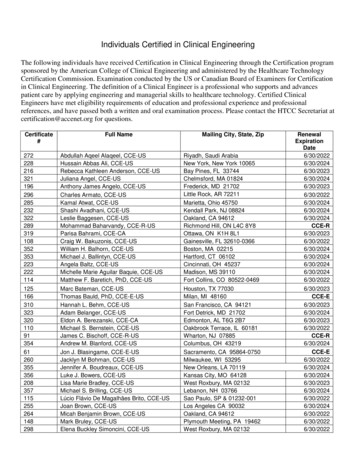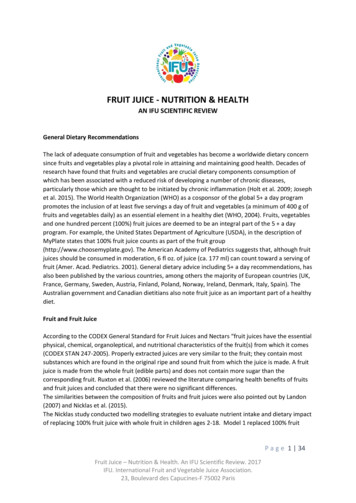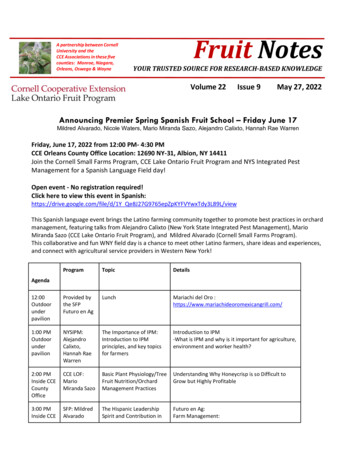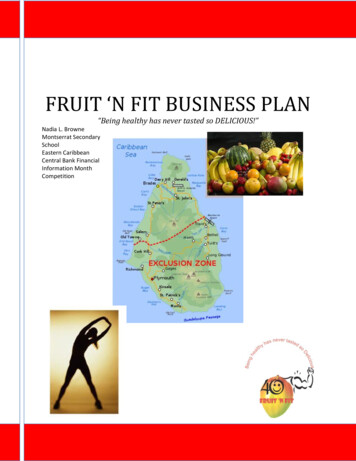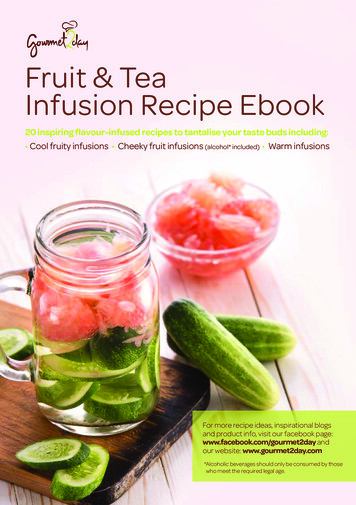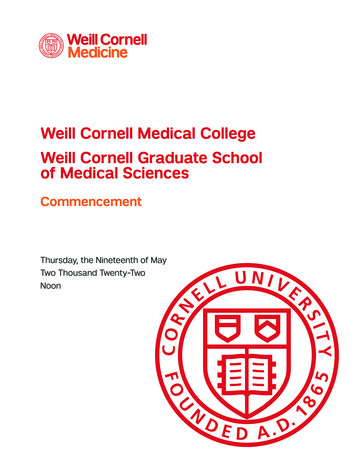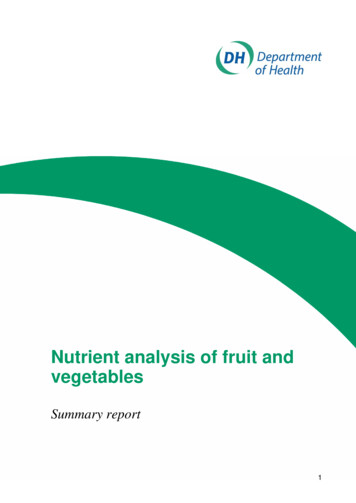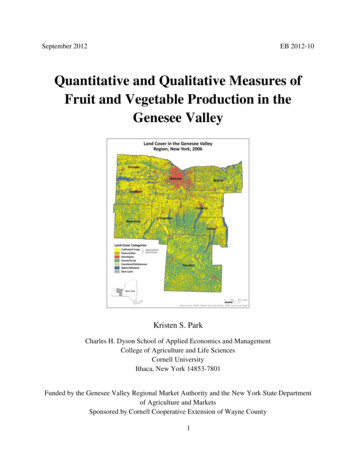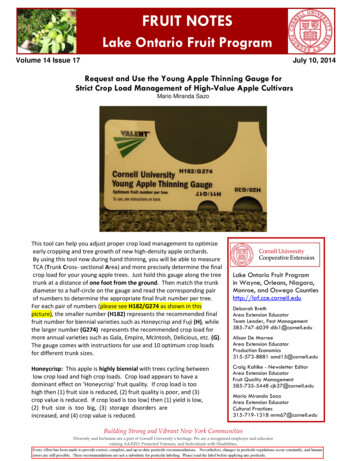
Transcription
FRUIT NOTESLake Ontario Fruit ProgramVolume 14 Issue 17July 10, 2014Request and Use the Young Apple Thinning Gauge forStrict Crop Load Management of High-Value Apple CultivarsMario Miranda SazoThis tool can help you adjust proper crop load management to optimizeearly cropping and tree growth of new high-density apple orchards.By using this tool now during hand thinning, you will be able to measureTCA (Trunk Cross- sectional Area) and more precisely determine the finalcrop load for your young apple trees. Just hold this gauge along the treetrunk at a distance of one foot from the ground. Then match the trunkdiameter to a half-circle on the gauge and read the corresponding pairof numbers to determine the appropriate final fruit number per tree.For each pair of numbers (please see H182/G274 as shown in thispicture), the smaller number (H182) represents the recommended finalfruit number for biennial varieties such as Honeycrisp and Fuji (H), whilethe larger number (G274) represents the recommended crop load formore annual varieties such as Gala, Empire, McIntosh, Delicious, etc. (G).The gauge comes with instructions for use and 10 optimum crop loadsfor different trunk sizes.Honeycrisp: This apple is highly biennial with trees cycling betweenlow crop load and high crop loads. Crop load appears to have adominant effect on ‘Honeycrisp’ fruit quality. If crop load is toohigh then (1) fruit size is reduced, (2) fruit quality is poor, and (3)crop value is reduced. If crop load is too low) then (1) yield is low,(2) fruit size is too big, (3) storage disorders areincreased, and (4) crop value is reduced.Lake Ontario Fruit Programin Wayne, Orleans, Niagara,Monroe, and Oswego Countieshttp://lof.cce.cornell.eduDeborah BrethArea Extension EducatorTeam Leader, Pest Management585-747-6039 dib1@cornell.eduAlison De MarreeArea Extension EducatorProduction Economics315-573-8881 amd15@cornell.eduCraig Kahlke - Newsletter EditorArea Extension EducatorFruit Quality Management585-735-5448 cjk37@cornell.eduMario Miranda SazoArea Extension EducatorCultural Practices315-719-1318 mrm67@cornell.eduBuilding Strong and Vibrant New York CommunitiesDiversity and Inclusion are a part of Cornell University’s heritage. We are a recognized employer and educatorvaluing AA/EEO, Protected Veterans, and Individuals with Disabilities.Every effort has been made to provide correct, complete, and up-to-date pesticide recommendations. Nevertheless, changes in pesticide regulations occur constantly, and humanerrors are still possible. These recommendations are not a substitute for pesticide labeling. Please read the label before applying any pesticide.
This cultivar requires precise and early crop loadmanagement for optimum floral return and fruitquality. We expect, if needed, you already finishedearly hand thinning of this cultivar at the 30-32 mmfruit size stage by utilizing the CU thinning gaugethis season. Now is the time to begin return bloomsprays for next 2015 year (review the return bloomspray article in this newsletter).NY1 and NY2: With young trees (planted in 2013 orearlier) that have a crop, the unsupportedterminal portion of the leader above the last wireshould be defruited for maximum shoot growth andgood lignification during years 2, 3 and 4.Interestingly, the wrapping of the leader around avertical wire stabilizer works, supports the leader,and encourages new growth above where it issupported by a tie at the trellis wire.For NY1 trees which had moderate or poor growthin the first year or were planted on a weakrootstock, these trees should be de-fruited in year 2(and in very few cases in year 3) because fruits willoutcompete with overall tree and shoot leadergrowth for carbohydrates and water. NY1 treesplanted this year should not carry a crop.Planning Ahead with Midsummer GrassesM. Miranda Sazo and S. A. HoyingNote: For more details on how to improve the soilhealth of your future orchard, please review CarolMacNeil’s article published by CCE-LOF newsletter,Vol 14, Issue 2, May 14, 2014.Growers who are planning to plant a new orchardsite (or a replant site) next year can consider theuse of cover crops before planting an orchard.Their benefits are numerous. When used they can:(1) improve organic matter, (2) break upcompaction layers in the soil profile, (3) suppressweeds, and (4) control erosion. We recommend theuse of sudangrass (see Table 1), but several othercover crops can be used. A more complete list ofcover crop options can be found at the web siteprepared by Thomas Björkman(http://covercrops.cals.cornell.edu/). This tool wasoriginally designed for vegetable growers, but is stillvery useful for fruit growers as well.Sudangrass and sorghum-sudangrass aremidsummer grasses suitable for short, 8-10 weekplantings. Sorghum-sudangrass is often referred togenerically as Sudex. These grasses are the mostheat and drought- tolerant cover crops typicallygrown in the Northeast. Sudangrass growth iseasier to manage because the stems are narrower,it can be sown earlier than sorghum-sudangrass,and suppresses weeds better. These crops provideabundant root biomass, which is useful forincreasing soil organic matter. Mowing encouragesroot growth. They suppress root knot nematodesand inhibit weed germination if densely sown.A few management tips: (1) land preparation:prepare a clod-free seedbed. Avoid hard soil andwet spots. Do not plant just before a heavy rain, (2)seeding rate: 30 lbs/acre for biomass and nematodecontrol, 50 lbs/acre for weed control, (3) seedingdate: June through mid-August (sudangrass), Julythrough mid-August (sorghum-sudangrass). Thesecover crops require warm soil to germinate, (4)maintenance: mow when 20-30 inches tall, leaving asix inch stubble. Two cuts in average can beconducted per season with sudangrass. Leaveresidue on the soil surface for weed suppression.Timely mowing is important because tall, fibrousplants are difficult to mow or incorporate, and (5)control: big crowns decompose slowly, making itdifficult to prepare a seedbed for small-seededcrops. Incorporate sudangrass if plantingsomething else in the fall. Otherwise, mow forwinter-killed mulch on the surface and till in earlyspring. Tall, unmowed sudangrass will winterkill,but is difficult to manage in the spring.
Table 1. Ideal Steps of Orchard Site Selection and Preparation and the Use of a Midsummer Grass (sudangrass) for anOrchard PlantingTimeYear 1Site selectionandPlanningYear 2Primary sitepreparationSpringOrder treesDrainage evaluation and minoradjustmentsSummerSoil testingFirst lime application based onsoil sample interpretationFallDeep plowingApplication of phosphorousmore lime (if needed),manure/compostDisc and rakeHerbicidePlant cover crop (Sudangrass)to add organic matter andprevent weed growthMow @ 20-30” (at least 2 timesper season)Seeding rate: 30-50lbs/acreDeep plowing,rippingFumigate (35gallons/A ofTelone C-17 or25 gallons/A ofTelone C-35)Year 3Final preparationand plantingDisc or rototillSubsoilInstall irrigation (mains)Plant treesApply ¼ lb of Calcium nitrateafter the soil settles. Applyanother ¼ lb Ca nitrate 4 weekslater after shoot growth startsInstall irrigation linesSummary: By implementing the use of cover crops you will reduce erosion of topsoil from slopes and suppressweed growth. Proper site preparation will often involve significant disturbance of the soil in order to addamendments (lime, phosphorous), install drain tile, etc. If a cover crop is not established soon after soil work isfinished for the year, rainfall and melting snow can result in a significant loss of topsoil from the site. Sowing acover crop will also help to prevent the re-establishment of weeds that the grower has worked hard to eliminatefrom the site.Note: The sudangrass technical information was excerpted/modified from “Cornell cover crop guide forsudangrass”. Cornell University. 2pp. Ver. 1.100716 (Björkman, T. and J.W. Shail. 2010).Suggested Return Bloom Strategies for Western NY Fruit GrowersMario Miranda SazoRegardless of the thinning program used, biennialvarieties should receive additional sprays of eitherNAA or Ethrel about 4-7 weeks after bloom in order toenhance repeat bloom. This summer program isuseful for easy-to-thin biennial triploid varieties suchas Jonagold and Mutsu and it is also useful for hard-tothin, strongly biennial varieties such as Honeycrisp,Fuji, and Golden Delicious. Fruit size is now 50-52 mmat inland sites and will be 48-50 mm in the next 3-5days at lake sites. Once fruit size is 30 mm or more indiameter there is little risk of thinning by NAA orEthrel. This season Dr. Robinson is recommending theuse of Ethrel (0.5 pints/100 gallons or 1pt/Acre) forthe first spray for Honeycrisp, Macs, and Macoun, andthen switch to 3 sprays of NAA at 5ppm(2ounces/100gallon or 4ounces/acre). For lateripening varieties like Fuji, he recommends the use ofEthrel for the first two sprays and then switch to 2sprays of 5ppm NAA. With pears he also recommends4 applications of 5-7.5ppm NAA starting this week tostimulate flower bud initiation. He has only testedEthrel on Bartlett and Bosc pears one year whereEthrel worked better than NAA on Bosc but it is likelyto stimulate pre-mature ripening with Bartlett. Avoidreturn bloom sprays of Ethrel or NAA if temperaturesget in the high 80’s/low 90’s since application of thesematerials in hot weather or just prior to multi-days ofhot weather might contribute to leaf yellowing, earlyripening, smaller fruit size, and/or yield loss if ratesare high.
Black Stem Borer, Xylosandrus germanusDeborah Breth, Art Agnello, Elizabeth TeeThe black stem borer was introduced from easternAsia and first detected in NY in 1932. It has sincebeen detected in most parts of the US. It is ageneral wood boring insect in the group called“Ambrosia beetles” with a huge list of suitable hostsincluding American Beech, Maple, dogwood, blackwalnut, oak, magnolia, and several otherornamental and forest species. But it has also beendocumented in apple and sweet cherry in 1982. Wefirst detected black stem borer in 2013 in 6 sites inthe Lake Ontario Fruit Region of NY, and haveidentified at least 6 more sites in 2014.Come to the summer tour to see this pest and what itcan do to an orchard. This is a serious pest in forestry,ornamental nurseries, and now high density apples!We have been trapping this insect in several sitesacross the region and there was a peak emergence inearly June. The trap captures are tailing off comparedto early June, but we continue to catch significantnumbers. We have been dissecting the galleries in theyoung orchards and are finding eggs, larvae, and pupae,along with the adults that are taking care of the young.The research literature says there will be anotheremergence in late July- early August. We have nothingregistered for control of these pests. The ornamentalnursery industry where this is a serious pest relies onpyrethroids on a 2-week schedule which will certainlybe a challenge in apples with concerns for mite control.Art Agnello, Kerik Cox, and I are working on this pest tobetter understand the biology and identify viablecontrols. If you see these pests call us so we candocument the economic damage and continue work onthis pest.In the meantime, for newly planted orchards, do not belax in insecticide applications for control of leopardmoth, aphids, potato leafhoppers, and be diligentlooking for the tiny 1 mm diameter holes in bark ofsmall trees. If you find it, rogue the trees and burnthem immediately since the tiny beetle will leave therogued trees and return to the orchard and infestanother tree.Cruising AltitudeArt AgnelloOur summer once again seems to havebypassed the traditional July warming-upphases and jumped straight to August-likedog-days, complete with recurringafternoon pop-up thunderstorms. This typeof weather pattern tends to benefit someinsect pests and hinder others. Thefollowing is a brief rundown of some itemsto keep near the top of your "scramble" list,just to help prevent anything from boilingover.Internal LepsWe are still generally in between the firstand second flights for both codling mothand oriental fruit moth. The first brood CMhatch essentially ended last week, so mostsites with traditionally heavy pressure fromthese pests should have already addressedfirst generation larval control needs. Lookfor the first captures of the 2nd flight forpurposes of timing management sprays; weshould note a definite uptick in trapnumbers within the next 7–10 days,especially if the current hot spell continues.Obliquebanded LeafrollerAccording to our developmental models, the firstsummer brood hatch should be anywhere fromabout 50-90% complete around the state this week.Orchards with historically high OBLR pressureshould have received an application of a suitablematerial during the first part of July, so this weekwould be the latest possible time for such anapplication against the larvae of this brood if theyhaven't been attended to. Delegate, Altacor, Belt,Rimon and Proclaim are appropriate choices,particularly in cases where the larvae are a bitlarger, and a B.t. product such as Dipel, or else theIGR Intrepid are also options, but these tend to bemore effective when applied against the earlierstages. If you are applying Belt, Altacor or Delegateto control codling moth and oriental fruit moth,they will also be very effective against OBLR at thistime. Regardless, we have found that this specificspray is the most critical for preventing fruit-feeding
damage at harvest, so put this at the top of your listApple MaggotAdults made their first appearance inGeneva last week, and should beginshowing up in traditional high-pressure siteselsewhere around the state this week.Stings and larval tunneling would first bedetected in early and favored varieties suchas Ginger Gold and Honeycrisp, particularlyin the Hudson Valley. If you aren'tmonitoring in specific orchards and haven'tyet made preparations for a protectivespray against AM (and aren't using Delegateor Altacor for OBLR, both of which havesome activity on AM), prudence wouldsuggest attention to this pest. Hanging afew volatile-baited sphere traps on theedge of susceptible plantings can providevaluable insight on when (and whether)immigrating flies are posing a threat.Growers on a Delegate or Altacor programfor leafrollers/internal leps should get someprotection against moderate AM pressure.For those not using Imidan in their coversprays, Assail and Calypso will both provideexcellent control of apple maggot as well asinternal leps.of priorities if OBLR has distressed you in the past.Woolly Apple Aphid (from Jim Eve)Individual nymphs have started to becomenoticeable in Wayne Co. as they make theirway up into the canopies of infested trees,although no actual aerial colonies have yetbeen seen. This would be a prudent time tobegin a preventive spray program for thispest in blocks with historically highpressure. Quoting from the June 9 issue'soverview of treatment options:'WAA is resistant to the commonly usedorganophosphates, but other insecticidesare effective against WAA, includingDiazinon and Thionex, and some newerproducts such as Admire, Assail, Beleaf, orMovento may offer suppression (forMovento and Assail, addition of a non-ionicsurfactant or horticultural mineral oil willimprove activity). Good coverage to soakthrough the insects' woolly coverings isintegral to ensuring maximum efficacy.Additionally, a Lorsban trunk application forborers made at this time will effectivelycontrol any nymphs that might becontacted by these sprays.' But if you useda Lorsban (chlorpyrifos) prebloom, achlorpyrifos trunk spray is not an option.Focus on Food Safety Series – Part 4Selected Case Studies of Foodborne Illness Outbreaks in the US & EuropeCraig Kahlke & Betsy BihnDue to lack of space, you’ll find the previous (part 3)article in this series, in the LOF newsletter, Vol 14,Issue 10, April 30, 2014. To summarize the majorproduce-associated foodborne illness outbreaksthat have occurred over the past 50 years is notpossible within the scope of this newsletter, so onlythree will be highlighted here. Table 1 lists a “Top10” US & Europe Foodborne Outbreaks Related toProduce” along with several other resources thatare listed at the end of this publication to provide amore comprehensive look at foodborne illnessoutbreaks. In addition, a nice publication entitled“Ranking the Risks: The Top 10 Pathogen-FoodCombinations with the Greatest Burden on PublicHealth” can be found at this /1022/72267report.pdf.Three Produce-Associated Foodborne IllnessOutbreaks2006 E.coli 0157:H7 outbreak associated withspinach. In September 2011, news of this outbreakhit the media like a storm as the FDA’s originalrecommendation was for consumers to stop eatingspinach until the source of the outbreak wasidentified. Finally the source of the outbreak wastraced to one large field in California. The outbreakinvestigation identified risks that included fieldintrusion by feral pigs, surface water contaminatedby animal feces used for irrigation, and adjacentland use included cattle grazing. This outbreakresulted in at least 276 consumer illnesses and 3deaths attributed to the tainted produce.1 Thirtyone people ended up suffering hemolytic uremic
syndrome , a serious condition often resulting inkidney failure, with many more suffering bloodydiarrhea and dehydration. The hospitalization rate forthis outbreak was over 50%. In response to thisoutbreak, some of the largest grocery chains sent aletter to the farmers’ associations, giving them 6weeks to come up with a plan to prevent problemslike the E. coli O157:H7 outbreak from happeningagain. The result was the Leafy Greens MarketingAgreement, which set strict GAPs standards for theproduction and postharvest handling of fresh leafygreens in CA and AZ. The West Coast spinach industryis just now recovering from the impact of thisoutbreak as spinach consumption trends return topre-2006 levels. For the US, this was the “gamechanger” in regards to public awareness of produceassociated foodborne illness outbreaks and industryawareness of the pain and suffering of those affectedas well as the liability and financial losses to theproduce industry as a whole.2008 US salmonellosis outbreak associated withpeppers and (originally) tomatoes. In the spring andsummer of 2008, the rare Saintpaul serotype ofSalmonella enterica caused at least 1442 cases ofsalmonellosis in 43 states throughout the US.2 It wasthe largest reported salmonellosis outbreak in theUnited States since 1985, and the largest caused byproduce in the last 50 years. There were at least 257reported hospitalizations linked to the outbreak,leading to at least one death, and the outbreak mayhave been a contributing factor in at least oneadditional death. At first, the major uniting factor inthe illnesses seemed to be fresh, raw tomatoes butthe pathogen could not be isolated from tomatoes.This complication in identifying the origin andcommodity associated with the outbreak severelyimpacted the tomato industry since sales andconsumption dropped dramatically as the tracebackinvestigation continued. As the investigation widened,raw jalapeno & serrano peppers, along with cilantroand bulb onions were also implicated. Finally theSaintpaul serotype of S. enterica was isolated fromfresh raw jalapeno at a distributor on the TexasMexico border.3 The FDA later found samples of theoutbreak strain of Salmonella in samples of serranopeppers and groundwater at a Mexican farm. There ismuch more to this complex story, but it highlightsboth the impact to public health as well as the impactto the produce industry was identifying the source ofcontamination is delayed. A good summary can befound in this CDC update at this no/index.html2011 US listeriosis outbreak associated withcantaloupes. In the summer and fall of 2011, theUnited States saw an outbreak of listeriosis caused bythe pathogen Listeria monocytogenes associated withcantaloupes from Colorado. Although the outbreakbegan in July, illnesses were still being reported inDecember, due to the long incubation period of thispathogen in some individuals. When the outbreakwas over, thirty people had died and 128 weresickened in 28 states, making it the second deadliestrecorded U.S. outbreak since the CDC began trackingoutbreaks in the 1970s.4 The FDA found positivesamples at a broker of the cantaloupe that linkedthem to one farm (Jensen Farms) in a cooperative ofEastern Colorado cantaloupe growers. Subsequently,the FDA found positive Listeria samples at Jensenfarms packing facility, including on brushes in thewashing equipment that was originally designed forpotatoes. Lack of proper sanitation of this equipment,allowed the L. monocytogenes to become establishedwithin the equipment and subsequently contaminatecantaloupes that moved through the washer. It is notclear how Listeria was first introduced into theequipment, but Listeria was found in cull piles innearby fields, in standing water under the packingequipment, in palleted fruit in a refrigerated coolerawaiting shipment, and in fruit in consumers’refrigerators. It is important to note that Jensen farmsreceived a 96/100 score in an early season Primusfood safety audit, so the growers likely thought theirfood safety program was well implemented andeffective at reducing risks. In hindsight, this outbreakhighlights many lessons including the importance ofequipment sanitation and the risks that Listeriamonocytogenes presents in fresh produce operations.In addition, it provides many points for discussing thevalue of third party audits as well as the importance ofthe competence and training of auditors. For moreinformation, please see the CDC’s last update sjensen-farms/.We would love to have your suggestions, soplease email Craig at cjk37@cornell.edu tosuggest article topics or share your thoughtsabout how Cornell Cooperative Extension canhelp improve the implementation of producesafety practices in New York.
Figure 1. “Top 10” US & Europe Foodborne Outbreaks Related to ProduceNotes* see O, CA, WA,CanadaN. America(NE OH & SW PA)N. America6N Amer.- 43states, plusCanadaGermany & 15other countriesUS – 28 states7US- Oregon8US-24 states9US- Arizona10US- NYWashingtonCounty5DeathsE.coliO157:H7Hepatitis AApple juice(unpasteurized)Green Onions1996 701SeeFootnoteslinked toourwebsitebelowA2003 3394BE.coliO157:H7SalmonellaentericaSpinach2006 2753CJalapeno &serrano peppers2008 uts2011 3,95053ECantaloupe2011 14530FStrawberry2011 151GCantaloupe2012 2603HLettuce2013 90noneIDrinking water1999 1,0002JPlease click here for the footnotes to the table above that links to more info about individual outbreaksin the table above. http://lof.cce.cornell.edu/submission.php?id 232&crumb food safety food safetyAdditional References1. FDA Statement on Foodborne E. coli O157:H7 Outbreak in Spinach, ssAnnouncements/2006/ucm108761.htm,accessed 5-8-14.2. Centers for Disease Control and Prevention, dex.html , accessed 5-2-14.3. Behravesh CB , Mody RK, Jungk J, Gaul L, Redd JT, et al. 2011. 2008 Outbreak of SalmonellaSaintpaul infections associated with raw produce. N Engl J Med Mar 10;364:918-927.4. FDA, Final Update on Multistate Outbreak of Listeriosis Linked to Whole Cantaloupes. rgencies/Outbreaks/ucm272372.htm#final
Lake Ontario Fruit ProgramCornell Cooperative Extension12690 State Rt. 31Albion, NY 14411Contents: Request and Use the YoungApple Thinning Gauge forStrict Crop LoadManagement of High-ValueApple CultivarsPlanning Ahead withMidsummer GrassesSuggested Return BloomStrategies for Western NYFruit GrowersBlack Stem Borer, XylosandrusgermanusCruising AltitudeFocus on Food Safety Series –Part 4 -Selected Case Studiesof Foodborne IllnessOutbreaks in the US & EuropeLOF Summer Tour July 24Save the Dates: DEC WPSMock InspectionsCCE-LOF SUMMER TOUR - JULY 24The 2014 Lake Ontario CCE Summer Fruit Tour will take place on July 24, and will feature New Technology in theOrleans/Niagara Co. Fruit Industry. The stops and topics include: Kast Farms, Lattin Rd., Albion - Gala, NY1, & NY2 plantings, economics, and management, including de-fruitingtechniques; weed control in young trees; managing fire blight in young trees (Deb Breth, Alison DeMarree, Kerik Cox,Terence Robinson, Mario Miranda Sazo).Pettit Farms, Bates Rd., Medina - Black stem borer invasions; low vigor in NY1 & Honeycrisp (Deb Breth, Art Agnello,Terence Robinson).Ledge Rock Farms, Gravel Rd., Medina - NY1 & NY2 tall spindle plantings; precision chemical thinning (TerenceRobinson, Mario Miranda Sazo).Vizcarra Vineyards At Becker Farms, Quaker Rd., Gasport - Lunch and visit with sponsors and exhibitors. See equipmentdisplays. Oscar & Mindy Vizcarra will share the history of farm & market, winery and brewery. Juliet Carroll will givean update on spotted wing drosophila in berries and tree fruit.New Royal Orchards, Rt. 31, Gasport - new SDHI fungicides for scab and mildew; phytotoxicity demo with tankmixes; protecting sweet cherries from rain with Voen and other canopies (Kerik Cox, Deb Breth, Mario MirandaSazo, Terence Robinson, and Greg Lang - Michigan State)There is no charge to attend, thanks to Sponsor and Donor support, but please pre-register by July 18 (585798-4265 x26; or krh5@cornell.edu; or on LOF website: http://lof.cce.cornell.edu/ Don’t forget to registerfor the Retirement celebration to follow the summer tour for Alison DeMarree and Steve Hoying. July24 at 5 PM at Leonard Oakes Estate Winery, Medina, NY. 25/person. See details to register athttp://lof.cce.cornell.edu.Save the Dates- July 22 & 23, Worker ProtectionStandards Mock Inspections in Wayne & Ontario CountiesThe Department of Environmental Conservation, Bureau of Pest Management, will be conducting two Worker ProtectionStandard (WPS) mock inspections. The first will be on Tuesday, July 22, 2014 from 1-3 PM at De Marree Fruit Farms,located at 7654 Townline Road, Williamson, NY. The second WPS mock inspection will be conducted at the GenevaAgricultural Experiment Station, on Wednesday, July 23, 2014 from 10 a.m. - 12 p.m. No preregistration is required.Pesticide Applicator recertification credits will be offered.
585-747-6039 dib1@cornell.edu . Alison De Marreemore . Area Extension Educator . Production Economics . 315-573-8881 . amd15@cornell.edu. Craig Kahlke - Newsletter Editor . Area Extension Educator . Fruit Quality Management . 585-735-5448 . cjk37@cornell.edu . Mario Miranda Sazo Area Extension Educator Cultural Practices 315-719-1318 mrm67 .
